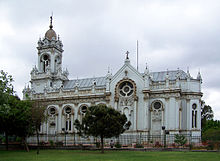Balat, Fatih
show This article may be expanded with text translated from the corresponding article in Turkish. (May 2018) Click [show] for important translation instructions. |


Balat is the traditional Jewish quarter in the Fatih district of Istanbul. It is located on the European side of Istanbul, in the old city on the historic peninsula, on the western bank of the Golden Horn.
The name Balat is probably derived from Greek palation (palace), from Latin palatium, after the nearby Palace of Blachernae. In the present day, the ruins of Poli Yashan ("Old City"), a former Jewish synagogue, are in this neighborhood. Some of the congregation of Poli Yashan went on to found the Poli Hadash, the latter name being a mix of Greek and Hebrew terms that means "New City".[1]
History[]

Balat first became home to a large Jewish population in the late 15th century, when Sultan Bayezid II offered citizenship to Jewish and Muslim peoples fleeing Inquisitions in Spain and Africa.[2] At its peak, Balat was home to 18 synagogues, though only two are still in use today: Ahrida Synagogue and Yanbol Synagogue. Or-Ahayim Hospital, opened in 1887, was originally set up for Balat's Jewish population, but today serves the general public.[3]
Although often referred to as the 'Jewish quarter' of Istanbul, Balat was historically home to a wide variety of ethnicities, cultures and religions.[4] The famous Bulgarian Iron Church is located in the district, and there was traditionally a sizeable Armenian population too.[5] The district's proximity to St. George's Cathedral and the Ecumenial Patriarchate of Constantinople also meant that there was a large Greek Orthodox (Rûm) population. However, Balat today is overwhelmingly Muslim, with most minority populations having left the district or having been forced to leave as a result of the Armenian genocide, Greek genocide, anti-Greek riots and expulsions throughout the 20th century.[6]
European travellers moving through the area from the 17th century onwards recorded Balat as being incredibly poor and unhygienic, though Bornes-Varol has argued that these reports may have not been true reflections of Balat as a whole, noting that while Balat was poor, travellers' accounts were largely based on their travels through Karabaş, the very poorest area of Balat.[7]
In 1985, Balat was inscribed on the UNESCO World Heritage List as one of the Historic Areas of Istanbul, and in the late 1990s and early 2000s was the subject of a number of controversial renovation and revitalisation projects.[8][9]
See also[]
Coordinates: 41°01′58″N 28°56′44″E / 41.0328°N 28.9456°E
References[]
| Wikimedia Commons has media related to Balat (Istanbul). |
- ^ Rozen, Minna (2010). A History of the Jewish Community in Istanbul:The Formative Years, 1453-1566. Brill. p. 11.
- ^ Egger, Vernon (2008). A history of the Muslim world since 1260 : the making of a global community. Upper Saddle River, NJ: Pearson Prentice Hall. ISBN 978-0-13-226969-8. OCLC 144548263.
- ^ Erbahar, Aksel (2010). "Or Ahayim Hospital, Istanbul". Encyclopedia of Jews in the Islamic World. doi:10.1163/1878-9781_ejiw_sim_0017050. Retrieved 2021-06-03.
- ^ "Balat: Living Together". Balat: Living Together. Retrieved 2021-06-04.
- ^ Ortaylı, İlber. "Anılar coğrafyası kıtalara yayılan semt" (PDF).
- ^ Mills, Amy (2008). "The Place of Locality for Identity in the Nation: Minority Narratives of Cosmopolitan Istanbul". International Journal of Middle East Studies. 40 (3): 385. doi:10.1017/s0020743808081312. ISSN 0020-7438.
- ^ Bornes-Varol, Marie-Christine (1994). "The Balat quarter and its image: a study of a Jewish neighborhood in Istanbul". In Levy, Avigdor (ed.). The Jews of the Ottoman Empire. Princeton: Darwin Press. p. 639. ISBN 978-0878500901. OCLC 649879656.CS1 maint: date and year (link)
- ^ Centre, UNESCO World Heritage. "Technical support for the management, enhancement and development of the Historic Areas of Istanbul, Turkey". UNESCO World Heritage Centre. Retrieved 2021-06-03.
- ^ Bezmez, Dikmen (2008). "The Politics of Urban Waterfront Regeneration: The Case of Haliç (the Golden Horn), Istanbul". International Journal of Urban and Regional Research. 32 (4): 824. doi:10.1111/j.1468-2427.2008.00825.x.
- Jewish ghettos in Europe
- Jewish communities in Turkey
- Neighbourhoods of Fatih
- Jewish history stubs
- Istanbul Province geography stubs

